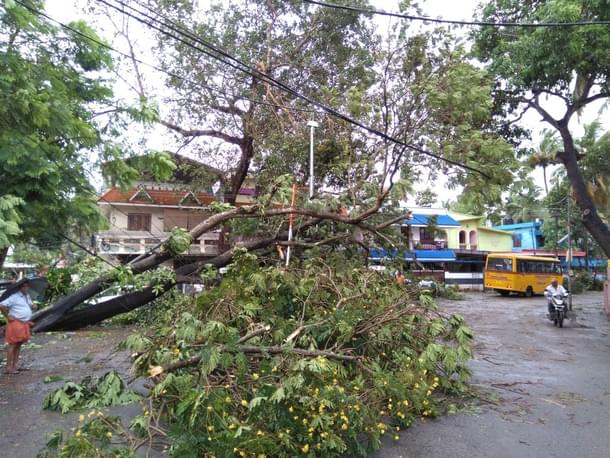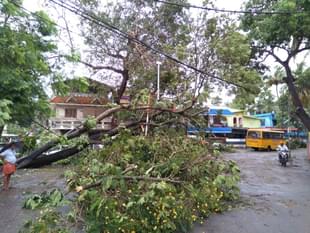Current Affairs
After The Cyclone: How The Disaster Management Authority Was Found Napping In Kerala
Rajeev Srinivasan
Dec 04, 2017, 01:04 PM | Updated 01:03 PM IST
Save & read from anywhere!
Bookmark stories for easy access on any device or the Swarajya app.


Cyclone Okchi terrorised southern parts of Kerala and Tamil Nadu, and the death toll on land is at least 14; much property has been damaged. In addition, at least 100-200 fishermen are feared missing off the coast. Cyclones are natural disasters, it is true; but they do not show up in a vacuum, unlike an earthquake. How come we were not better prepared? Who will pay for the damage? And the armed forces and the coastguard came through magnificently: but is this their role, and indeed, what should their role be?
It is not as though it was unknown that a cyclone was on its way. At least a week prior, I saw warnings on my smartphone app AccuWeather via America’s National Oceanic and Atmospheric Administration about heavy rain and chances of flooding in Chennai, Coimbatore, Kochi and Thiruananthapuram. Clearly, if this was known via short-term weather forecasts from US weather forecasters by 23 November or so, it was up to the authorities, especially the Disaster Management Administration, to keep on top of the situation and provide adequate warning to residents in the affected areas.
As one of those residents, I do not recall getting any serious storm warnings on TV or other media. In fact, around noon on 30 November when the cyclone hit, I was out in the street like many others on a rainy day, and was startled by rain squalls with furious bursts of wind gusting at up to 75 kmph. I almost got hit by a falling branch; lightly anchored things like billboards were getting ripped up and tossed around. Then I saw a college being evacuated, and realised that the district collector had declared an emergency and students were being sent home.
Based on information available, it appears that at least 100 fishermen are missing and unaccounted for, although over 200 have been rescued, and some have sought shelter as far afield as Maharashtra’s coast. This is after the Indian Navy and coastguard launched a massive search and rescue operation, using the P8i Poseidon submarine-hunter reconnaissance aircraft, Dornier aircraft, and a number of ships operating off the Kerala and Tamil Nadu coasts, especially in the vicinity of the fishing harbours in Vizhinjam, Thiruananthapuram and Neendakara, Kollam.
The loss of lives at sea was avoidable. There were also deaths on land from objects falling on people, and short circuits from downed power lines. A large number of people were evacuated from their homes. So where did the problem lie? There is finger-pointing, but the lesson is that we are woefully under-prepared. This comes despite loss of lives every year due to heavy rains and coastal erosions.
Part of it comes from the fact that cyclones are so rare on the west coast. We get complacent, treating it as a ‘black swan’ event so unlikely that we might as well ignore it. And so we do. I looked up the statistics, and cyclones are far more numerous and destructive on the Bay of Bengal coastline, but they are not all that infrequent on the Arabian Sea coast either.
In the time frame from 1892 to today, it appears there have been 23 cyclones, including 18 severe cyclones that hit this coast. That means one every five years or so on average. Anecdotal evidence on Twitter from @narenmenon1, @andanarayanan, @rajivchandran, et al suggests there were events in 1983, 1935 or so, but I personally cannot remember a single cyclone in my lifetime. I think this infrequency induces a certain complacency. Besides, the average citizen was not put to great inconvenience except for short power failures this time and maybe a stray tree that got uprooted.
The persistent rumour is that the meteorological department did its thing, but the disaster management authority failed to take it seriously. So far as I know the disaster management authority is a state government arm. The Malayalam media is full of stories that put the onus directly on the Kerala government for incompetence or worse. A story in the Kerala Kaumudi states bluntly that rescue boats worth crores sat idly by as fishermen died. I am baffled because it is a janakeeya (people’s) government run by the Communist Party of India (Marxist).
Only the armed forces and the coastguard came through. Defence Minister Nirmala Sitharaman deserves special kudos for immediate and decisive action. Non-stop, 24 by 7 operations by the forces, including P8i Poseidon submarine hunter/reconnaissance aircraft, Dornier aircraft, naval ships, and appeals to commercial shipping in the area helped rescue a couple of hundred fishermen caught out at sea. Some of them were also unwilling to abandon ship, even though they were short of food and water: they demanded that their disabled boats be towed to port.
As usual, the armed forced rose to the occasion. This raises three questions, though. First, who will pay for the expensive rescue mission? Logically, it should be the Kerala government for search and rescue operations off the Vizhinjam and Kollam coasts, and out all the way to Lakshadweep. There were fishermen who had set out as early as 28 November who were stranded, as they had not received any warnings. We should have a tort-like arrangement: the government of Kerala, which damaged them through negligence, should pay as though they did through malice forethought.
The second question is, where are all those who complained loudly about the Army building a civilian overbridge in a Mumbai railway station? Their take – rather absurdly, I thought – was that the armed forces being used in civilian activity is a bad idea. Logically that means they shouldn’t have participated in the civilian rescue after an emergency? No, that is clearly an idiotic argument because an army in peacetime needs to keep itself sharp and combat-ready even through civilian missions.
Third, are our coastguard and Navy up to the larger task of protecting the coast from enemies? We probably need to ramp up the coastguard, for instance at Vizhinjam and Colachel. There are installations of value right on the coast: for instance Koodankulam nuclear power plant. At the moment we are vulnerable to attacks from the Bay of Bengal, as there is not even a long-range radar except in the Andamans, or an air station that will continuously patrol the area with P8i Poseidon-class reconnaissance aircraft, especially as the Chinese ramp up their presence off our coastal waters.
Those who demonstrated incompetence need to pay the price, but at the same time, this incident should serve as a canary in a coalmine: the lesson is that we are deeply vulnerable to disasters and enemy action on the peninsular coast. There are not enough physical assets, and more importantly, a protocol and process for action. This is alarming for a nation with a long coastline.
Rajeev Srinivasan focuses on strategy and innovation, which he worked on at Bell Labs and in Silicon Valley. He has taught innovation at several IIMs. An IIT Madras and Stanford Business School grad, he has also been a conservative columnist for twenty years.




